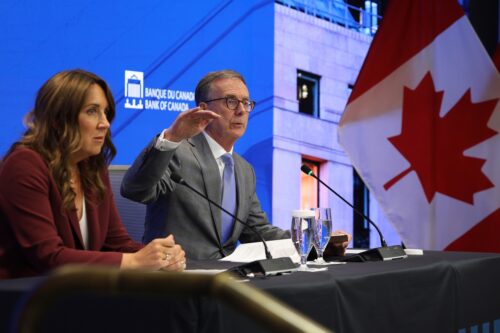By Erik Hertzberg and Randy Thanthong-Knight
(Bloomberg) — The Bank of Canada considered cutting interest rates at its last meeting, but trade uncertainty and sticky core inflation compelled officials to hold borrowing costs steady.
Policymakers discussed a quarter percentage point cut at their July meeting, but the ongoing trade dispute with the US, the resilience of the Canadian economy and mounting risks to inflation ultimately led the bank’s governing council to keep the policy rate at 2.75% for a third consecutive meeting.
“It was still too early to assess how tariffs and the rewiring of trade would affect economic activity and inflation in Canada,” the bank said in a summary of deliberations released Wednesday.
Members agreed they “would need to wait for more clarity before drawing firm conclusions” about whether there may be more room for easing, if the economy continued to weaken and core inflation pressures abated. That’s consistent with messaging from Governor Tiff Macklem during a news conference after the July decision.
Some on the governing council suggested they believe rates may not need to move lower.
“Some members held the view that, having reduced the policy interest rate to the middle of the bank’s estimated range of the neutral interest rate, and the economy showing some resilience to US tariffs, the bank may have already provided sufficient support to aid in this transition.”
Others flagged persistent economic slack, saying further monetary support would likely be needed, especially if the labour market deteriorated further.
Policymakers also discussed the role of monetary policy, saying it “is not well suited to shocks that push prices up because of decline in aggregate supply.”
Combined, the communications suggest that while officials recognize further easing may be necessary, they’re reticent to move forward with a cut until they get a better handle on the constantly evolving trade situation with the US and its impact on Canada’s exports and the broader economy.
Unlike the Federal Reserve, the bank’s summary of deliberations doesn’t outline individual members’ viewpoints or their preferred course of action for monetary policy.
Other key takeaways:
- Policymakers anticipated the economy to contract in the second quarter due to a sharp drop in exports
- They also expected business and residential investment to decline, while consumption and government spending rise
- Overall, they see more excess supply in the economy
- They agreed that the labour market remained soft
- Some members expressed concern about the risks of further increases in the unemployment rate and the implications for households if the trade war were to escalate or the effects were to spread outside of sectors reliant on trade
- Policymakers don’t see tariffs leading to a sharp rise in inflation
- They noted that the impact of tariffs on consumer prices so far appeared to be “modest,” and that wage increases and unit labour costs had continued to ease
- They see the appreciation of the loonie reducing import prices and no signs that inflation expectations had become de-anchored
- Officials reiterated that they see underlying inflation around 2.5%, though they provided no source or metrics for that calculation
Visited 42 times, 42 visit(s) today
Bank of Canada Bank of Canada meeting minutes bloomberg BoC deliberations summary of deliberations tiff macklem
Last modified: August 13, 2025
